Re. dimmer settings and hang height - right on
the manufacturer's product page. As is common with manufacturers, their guidance is conservative but this is more conservative than Mars. Their guidance will tend to be conservative because their goal is for you to have an excellent crop rather that you have a very good crop as long as you don't call for tech support or bad mouth them. (I wrote software for Apple for a few years and got some insight the tech support issue).
Photone—it can be accurate or it can be quite inaccurate.
If you use Photone, you should be using a diffuser (22# paper) or buy the diffuser from GLM.com. Also, make sure you've chosen the correct spectrum/light type in the settings window.
Seeing that there's a PPFD map for your light, you can do a "soft calibration" by putting the phone on the floor of the tent when the light is at various hang height and dimmer settings and comparing the Photone reading to the reading in the PPFD map. That should get you close enough.
"A light meter will tell you how much light is falling on your plant but only a plant can tell you how much light it can use."
In terms of how much light, a key point is the maturity of the plant. My belief/hypothesis is that the ability for a cannabis plant to process light mature by week 5 or 6. I say that because that's about the time when the vegetative state ends and one of the purposes of veg is to boil the infrastructure and processes that the plant needs for flowering (yeh, very obvious but it's a good place to start) and because I routinely grow my plants, autos and photos, at >=1k and I feed them that much light but about week 5.





